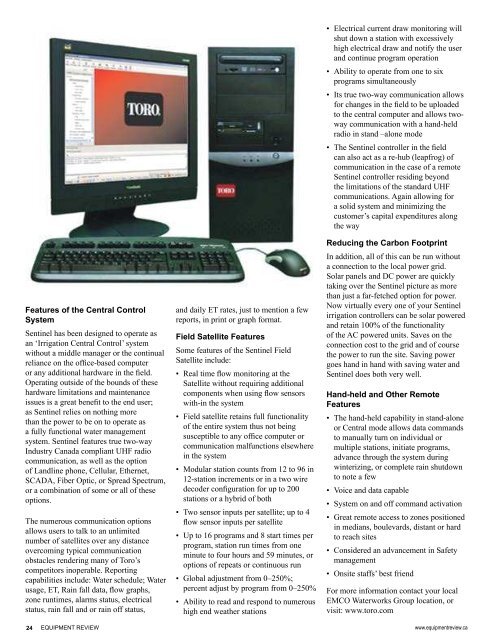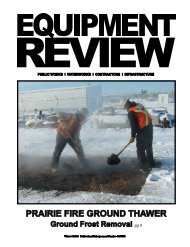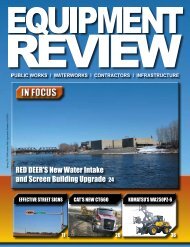Kenworth’s
Kenworth's - Equipment Review Magazine
Kenworth's - Equipment Review Magazine
- No tags were found...
You also want an ePaper? Increase the reach of your titles
YUMPU automatically turns print PDFs into web optimized ePapers that Google loves.
Features of the Central Control<br />
System<br />
Sentinel has been designed to operate as<br />
an ‘Irrigation Central Control’ system<br />
without a middle manager or the continual<br />
reliance on the office-based computer<br />
or any additional hardware in the field.<br />
Operating outside of the bounds of these<br />
hardware limitations and maintenance<br />
issues is a great benefit to the end user;<br />
as Sentinel relies on nothing more<br />
than the power to be on to operate as<br />
a fully functional water management<br />
system. Sentinel features true two-way<br />
Industry Canada compliant UHF radio<br />
communication, as well as the option<br />
of Landline phone, Cellular, Ethernet,<br />
SCADA, Fiber Optic, or Spread Spectrum,<br />
or a combination of some or all of these<br />
options.<br />
The numerous communication options<br />
allows users to talk to an unlimited<br />
number of satellites over any distance<br />
overcoming typical communication<br />
obstacles rendering many of Toro’s<br />
competitors inoperable. Reporting<br />
capabilities include: Water schedule; Water<br />
usage, ET, Rain fall data, flow graphs,<br />
zone runtimes, alarms status, electrical<br />
status, rain fall and or rain off status,<br />
and daily ET rates, just to mention a few<br />
reports, in print or graph format.<br />
Field Satellite Features<br />
Some features of the Sentinel Field<br />
Satellite include:<br />
• Real time flow monitoring at the<br />
Satellite without requiring additional<br />
components when using flow sensors<br />
with-in the system<br />
• Field satellite retains full functionality<br />
of the entire system thus not being<br />
susceptible to any office computer or<br />
communication malfunctions elsewhere<br />
in the system<br />
• Modular station counts from 12 to 96 in<br />
12-station increments or in a two wire<br />
decoder configuration for up to 200<br />
stations or a hybrid of both<br />
• Two sensor inputs per satellite; up to 4<br />
flow sensor inputs per satellite<br />
• Up to 16 programs and 8 start times per<br />
program, station run times from one<br />
minute to four hours and 59 minutes, or<br />
options of repeats or continuous run<br />
• Global adjustment from 0–250%;<br />
percent adjust by program from 0–250%<br />
• Ability to read and respond to numerous<br />
high end weather stations<br />
• Electrical current draw monitoring will<br />
shut down a station with excessively<br />
high electrical draw and notify the user<br />
and continue program operation<br />
• Ability to operate from one to six<br />
programs simultaneously<br />
• Its true two-way communication allows<br />
for changes in the field to be uploaded<br />
to the central computer and allows twoway<br />
communication with a hand-held<br />
radio in stand –alone mode<br />
• The Sentinel controller in the field<br />
can also act as a re-hub (leapfrog) of<br />
communication in the case of a remote<br />
Sentinel controller residing beyond<br />
the limitations of the standard UHF<br />
communications. Again allowing for<br />
a solid system and minimizing the<br />
customer’s capital expenditures along<br />
the way<br />
Reducing the Carbon Footprint<br />
In addition, all of this can be run without<br />
a connection to the local power grid.<br />
Solar panels and DC power are quickly<br />
taking over the Sentinel picture as more<br />
than just a far-fetched option for power.<br />
Now virtually every one of your Sentinel<br />
irrigation controllers can be solar powered<br />
and retain 100% of the functionality<br />
of the AC powered units. Saves on the<br />
connection cost to the grid and of course<br />
the power to run the site. Saving power<br />
goes hand in hand with saving water and<br />
Sentinel does both very well.<br />
Hand-held and Other Remote<br />
Features<br />
• The hand-held capability in stand-alone<br />
or Central mode allows data commands<br />
to manually turn on individual or<br />
multiple stations, initiate programs,<br />
advance through the system during<br />
winterizing, or complete rain shutdown<br />
to note a few<br />
• Voice and data capable<br />
• System on and off command activation<br />
• Great remote access to zones positioned<br />
in medians, boulevards, distant or hard<br />
to reach sites<br />
• Considered an advancement in Safety<br />
management<br />
• Onsite staffs’ best friend<br />
For more information contact your local<br />
EMCO Waterworks Group location, or<br />
visit: www.toro.com<br />
24 EQUIPMENT REVIEW<br />
www.equipmentreview.ca<br />
Summer 2012 EQUIPMENT REVIEW 25





